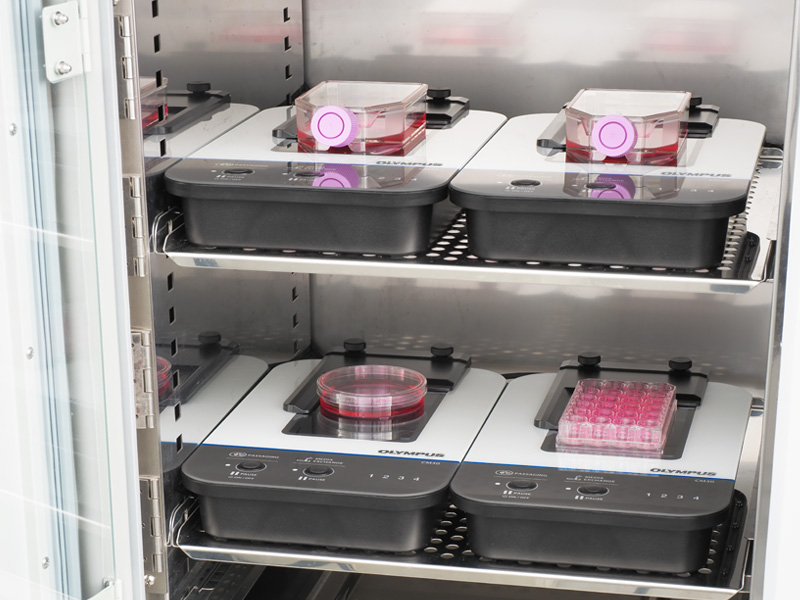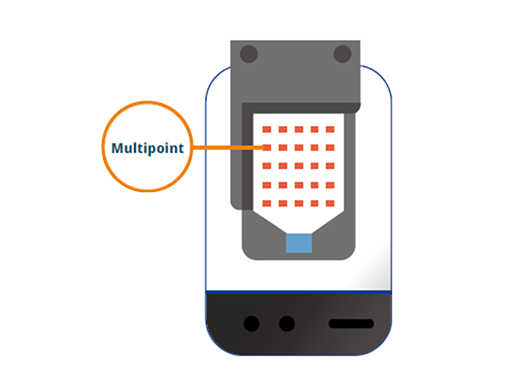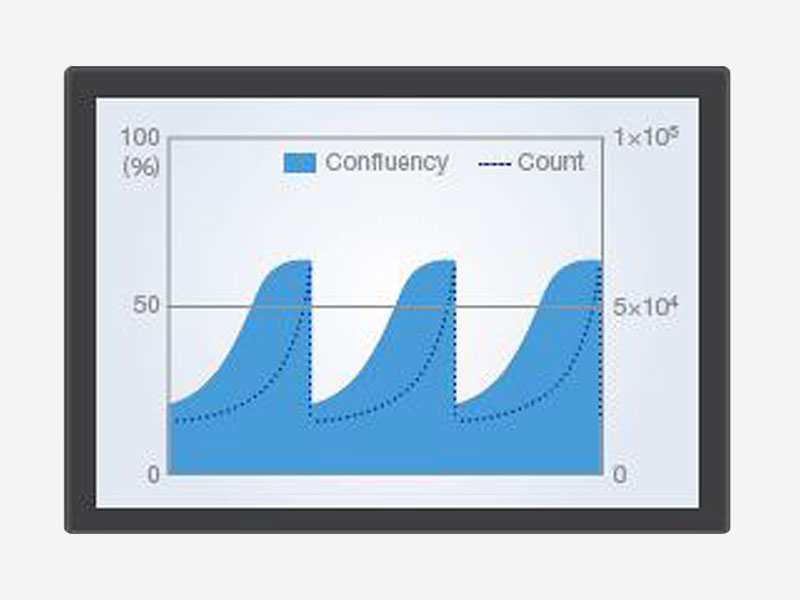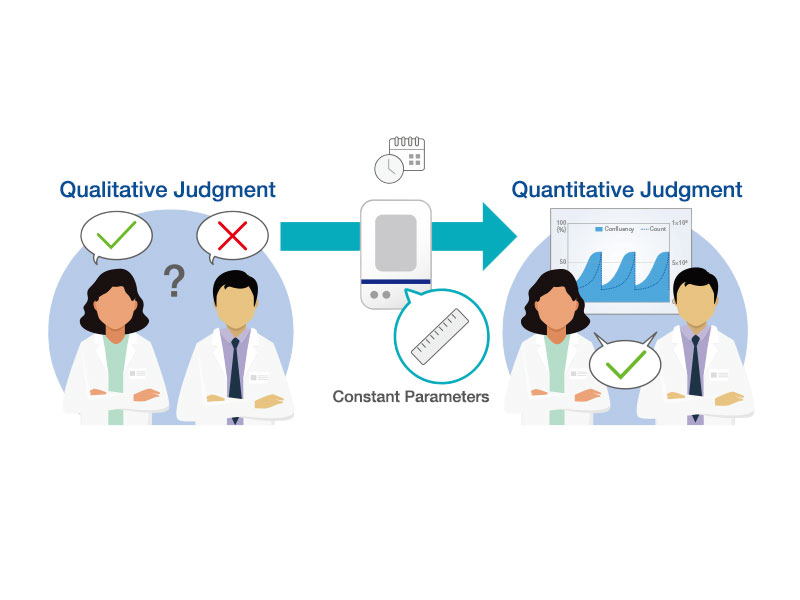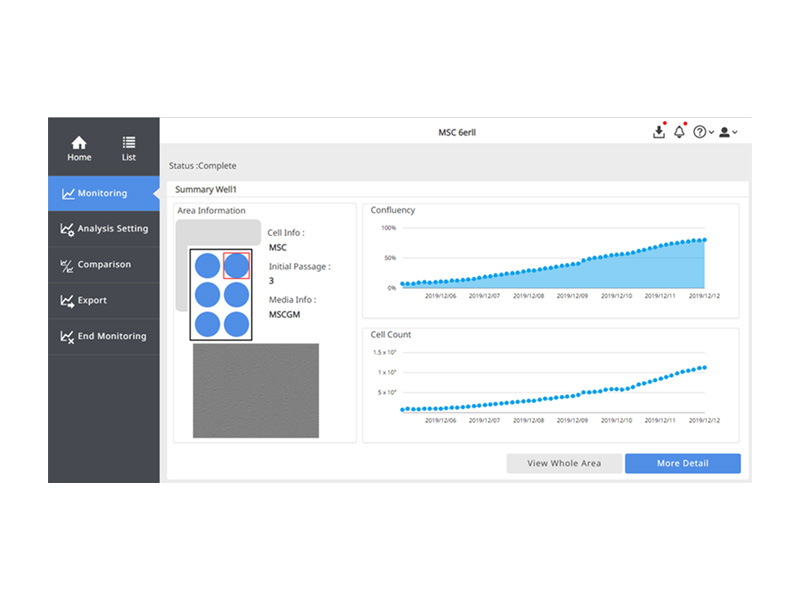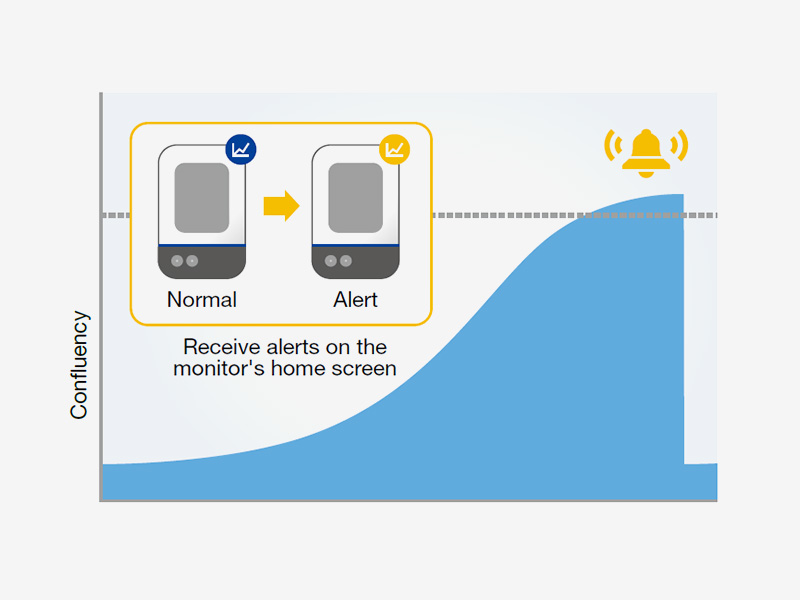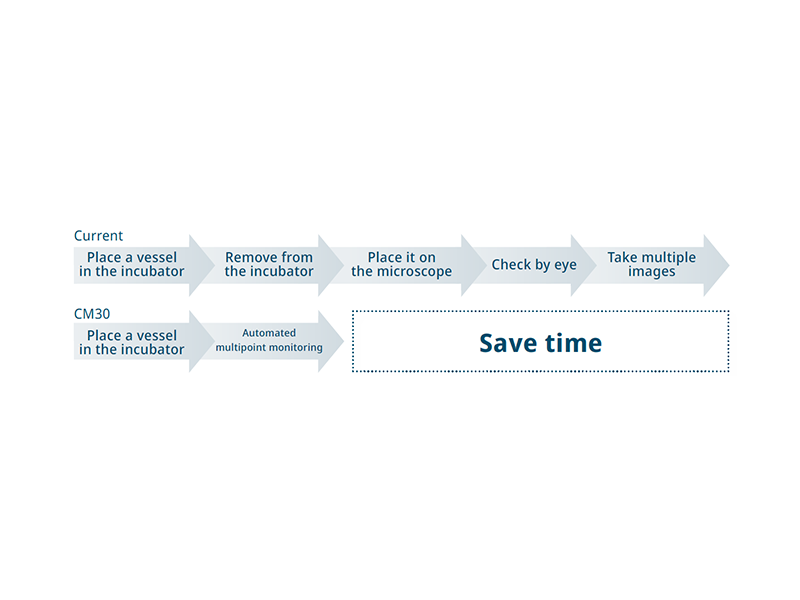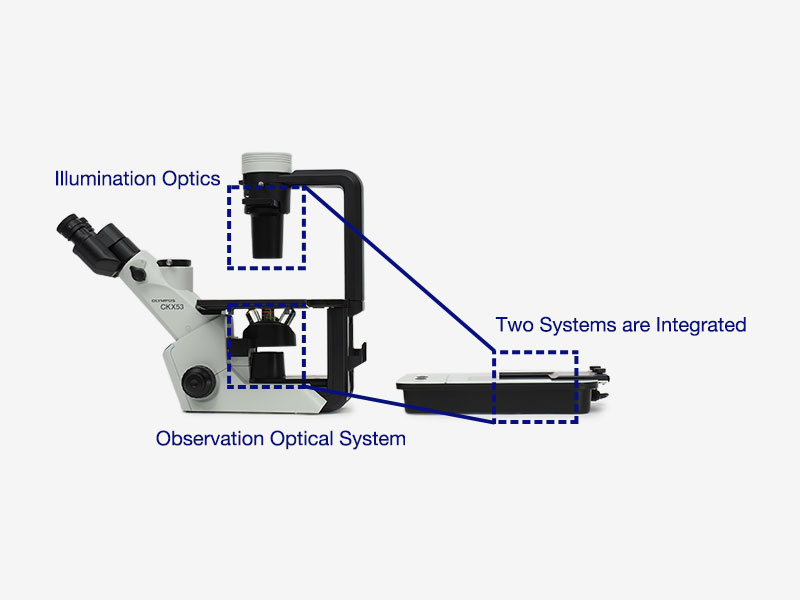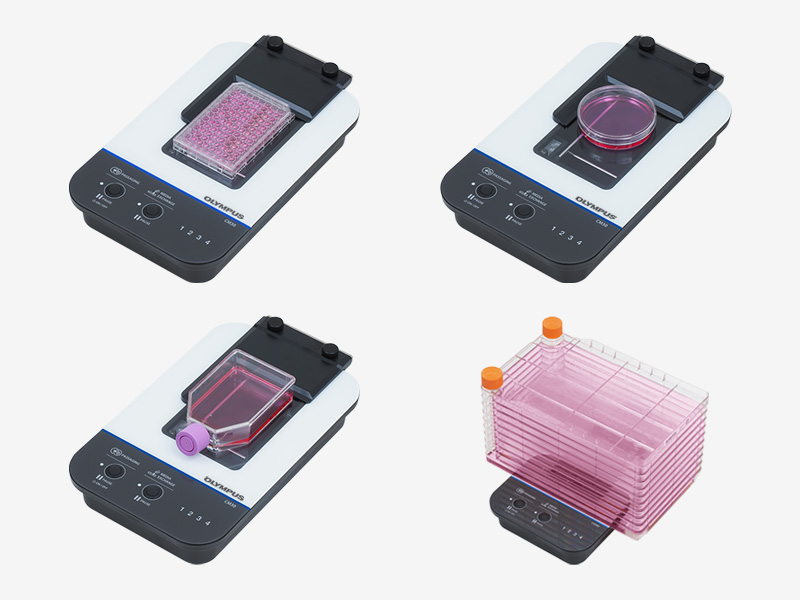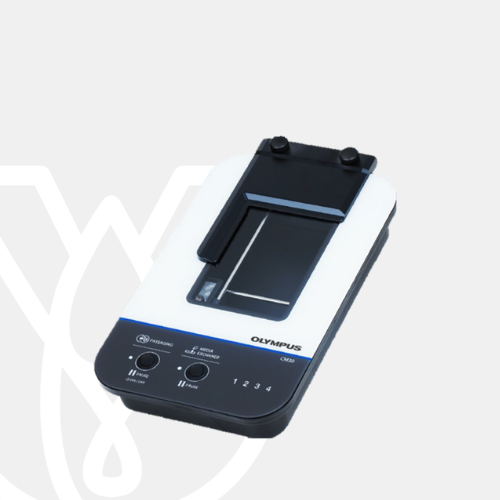
Olympus Incubation Monitoring System CM30
PT Wadya Prima Mulia as the Exclusive Distributor for Evident-Olympus in Indonesia, provides CM30 Incubation Monitoring System and other products.
Control Your Process with Smart Cell Culture Monitoring
Culturing cells can be costly, complicated, and time-consuming. With the CM30 incubation monitoring system, there’s a simple way to improve your culture process.
Improve the Cell Culture Process—
Label-Free, Quantitative Results
Label-Free Cell Monitoring
With the CM30 system, there is no need to stain the cultures to monitor their status. It acquires quantitative data from label-free cells, reducing the chance of harm to your cultures.
Multipoint Cell Culture Monitoring
The system automatically scans multiple points in your culture vessel, providing periodic quantitative data about the health and confluency of your cultures.
Consistent Results Throughout Your Lab
Constant Analysis Parameters
The CM30 system uses image analysis technology based on machine learning to continuously measure and analyze the images acquired. Constantly visualizing the culture status as a quantitative value eliminates factors that cause variations in cell checks and contributes to the reproducibility and consistency of experiments.
Compare Data Across Multiple Samples
Using multiple heads helps you maintain a control sample while multiple test protocols run at the same time. Share your data with team members or compare it to past data.
Customize the Analysis Parameters to Suit Your Experiment
The CM30 system automatically performs confluency, cell counts, and colony counts from acquired images. You can configure the system’s analysis parameters to suit each cell culture’s conditions, such as cell type, culture conditions, or drug administered. Knowing the stepwise cell culture status at each timing improves the accuracy of the experiment.
Cost Effective
Save Time with Automation
Improve your traditional microscopy-based workflow and get more accurate results in less time. By automating cell culture monitoring using the CM30 system, you can expand your research and use your time more effectively
No Need to Enter the Clean Room for Monitoring
Every time you enter the clean room, there is an operational cost for consumables and measurements. Now, you no longer constantly need to check cell culture status outside the incubator. You can reduce your costs by remotely checking the status of your cultures from outside the lab.
Accurately Time Cell Passage
Time cell passages consistently and without the subjectivity associated with manual counting. Based on your set standardized parameters, the software can indicate when your cells are ready for passage, helping prevent failures.

Tokyo Medical and Dental University
Institute of Research
Numerous researchers may be curious about the biological mechanisms involved in the long-term culturing required for the formation of stem cells and organoids within an incubator. I was honestly surprised that such a simplistic microscope is poised to address these questions as this CM20* can visualize spheroid formation and organoids cultured in an extracellular matrix gel with amazing contrast. I believe that CM20 can be a transformative tool in a wide range of cell biology experiments.

Translational Cardiovascular
Research Center University of Arizona
Dr. Erik Blackwood and his team have implemented the CM20* incubation monitoring system to optimize their cell culture monitoring process. They use the system to determine when cell lines are ready for their preclinical trials in rodent models for heart failure. Their approach focuses on identifying small molecule drug-based therapies, but also on gene therapy approaches. The count and confluency calculation capabilities of the CM20* system enable the researchers to monitor the effects of these therapeutics on iPS (induced pluripotent stem) cell lines in real time while the cultures remain safely in the incubator. Utilizing the system’s automated data gathering functions also increases their workflow efficiency.
Learn how Dr. Blackwood and his team improved their cell culture workflow with the CM20* monitoring system.

Mr. Yoshihito Tachi
I’m in charge of research and development of an autologous chondrocyte kit and conduct cell culture under various conditions when examining the culture protocol. I previously used a microscope to observe the conditions of cultured cells, but I can only make a qualitative evaluation with this method. Another challenge is that the analysis results vary depending on the experience and subjectivity of the worker. In contrast, the Olympus CM20* system can count cells and measure confluency with the same constant analysis parameters for highly reproducible and consistent analysis results. We can compare data between experiments when changing culture conditions, compare it with past data, and easily share it within the team— all of which can help us improve development efficiency. We’re also considering using it as an educational tool. By seeing the indicators, such as adhesion rate, uniformity, and proliferative ability, we can better evaluate the skills of workers.
*The user comments above were made after using the CM20, but the same results can be obtained using the CM30.
Leave Your Cultures in the Incubator
The monitor lets you track the health of cell cultures without removing them from the incubator, reducing the risk of contamination or damage from temperature changes and vibration. Its unique design enables you to fit up to four head units inside a standard incubator for greater efficiency.

Flat Design Accommodates Various Vessels
Evident’s epi-oblique optical system enables the CM30 incubation monitoring system to have a compact, flat design that accommodates most standard cell culture vessels. Simply place the culture vessel you normally use on the CM30.
AI-Driven Automated Cell Analysis
By training the system to distinguish between the cells and background using machine learning, it can automatically determine confluency.


Reproducible, Comparable Data
The CM30 makes it easy to store and share detailed quantitative records of cell growth and health.
- Graph confluency data to look at cell counts and colony analysis in chronological order to see how they’ve changed over time
- The comparison function makes it simple to compare current data with past results or to compare between wells
- Enables you to quickly calculate cell characterization data, such as doubling time and the population doubling level (PDL)
Customize the Settings to Meet Your Needs
Monitoring points
Set the monitoring points in the vessel and well plate anywhere you would like, as shown in the vessel on the right. By specifying the rows and columns, you can set multiple points at once.
Focus position
Freely set the focus position for each monitoring point.
Monitoring time
Freely set the start time and interval time.


Application Programming Interface (API)
to Freely Control the Acquisition Parameters (β ver.)
Remote, independent control of the CM30 head to:
Set key parameters
- Illumination
- Stage (XY, Z)
- Focus(autofocus/ manual focus)
- Exposure and image capture
Image Capture and Acquisition
- Static image capture
- Live preview
- Acquire and delete image data
- Obtain the list of images
IQ/OQ Validation Service
Our world-class support team can help you integrate the CM30 incubation monitoring system into your lab. IQ/OQ validation services are also available.

CM30H: Incubation Monitoring Head
| Installation environment (inside the incubator) | Temperature: 37 °C (98.6 °F) + 0.3 °C (0.5 °F), humidity: 0—99% |
| Applicable vessels | Petri dish (90 mm (3.54 in.), 100 mm (3.94 in.)) |
| Microplate (6 well, 12 well, 24 well, 48 well, 96 well) | |
| Flask (T25, T75, T80, T150, T175, T225) | |
| Multi-layer flask | |
| Optical performance | Field of view (H × V): 2.84 mm × 2.13 mm (0.11 in. × 0.08 in.); (image size per one shooting) |
| Image size: 1280 × 960 pixels | |
| Illumination wavelength: λ = 630 nm (LED) | |
| Illumination method: epi-oblique illumination | |
| Cable length | Approx. 4.5 m (14.8 ft) |
| Sterilization resistance | Autoclave sterilization (for vessel holder and sponge rubber only) |
| UV ray sterilization | |
| Hydrogen peroxide (H₂O₂) gas sterilization (CM30H only) | |
| Disinfection resistance | Peracetic acid disinfection (cold sterilant) |
| Alcohol disinfection | |
| Weight | Approx. 3.1 kg (6.8 lb) |
Incubation Monitoring Station
| Number of connectable CM30H | Max. 4 heads |
| HDD capacity | 4 TB or more |
Software
| User Management | 1000 user licenses (max) | |
| Project setting | Project creation: new or load | |
| Settings: standard or custom | ||
| Culture conditions: vessel information, culture information etc. | ||
| Cell analysis conditions: new or load | ||
| Access authority: public or private | ||
| Imaging interval: selection type | ||
| Analysis | Cell analysis: cell confluency, cell count | |
| iPS/ES cell analysis: colony confluency, colony count, colony size | ||
| Data statistics: growth rate, doubling time | ||
| Browsing | Image: entire area (tiling), fixed points | |
| Analysis result: graph (time, passage) | ||
| Export | Data export: image file, movie file* CSV file* *only for fixed points | |
| Create report (PDF) |
Client PC (Recommended System Configuration for CM30 Software)
| OS | Microsoft® Windows® 10 (64-bit) or higher |
| CPU | Intel® Core TM i3 (2.1 GHz) or more |
| RAM | 4 GB or more |
| HDD | Free space: 2 GB or more |
| Screen resolution | 1366 × 768 or more |
| Web browser | Google Chrome TM |
Operation Confirmed Incubator
| Thermo Fisher Scientific | 51030388 |
| Panasonic | MCO-170AICUVH-PJ |
| ASTEC | SMA-165DRS |
| Eppendorf | CellXpert® C170i (Operation confirmed by Eppendorf)
Reference data:Remote and quantitative cell culture monitoring: Vero cells |
Incubator conditions required for use of the CM30 system:
- The minimum height of the CM30H installation space must be 150 mm (6 in.)
- There must be an access port through which the CM30H cable can be taken out
For other products from Evident-Olympus, click here.

